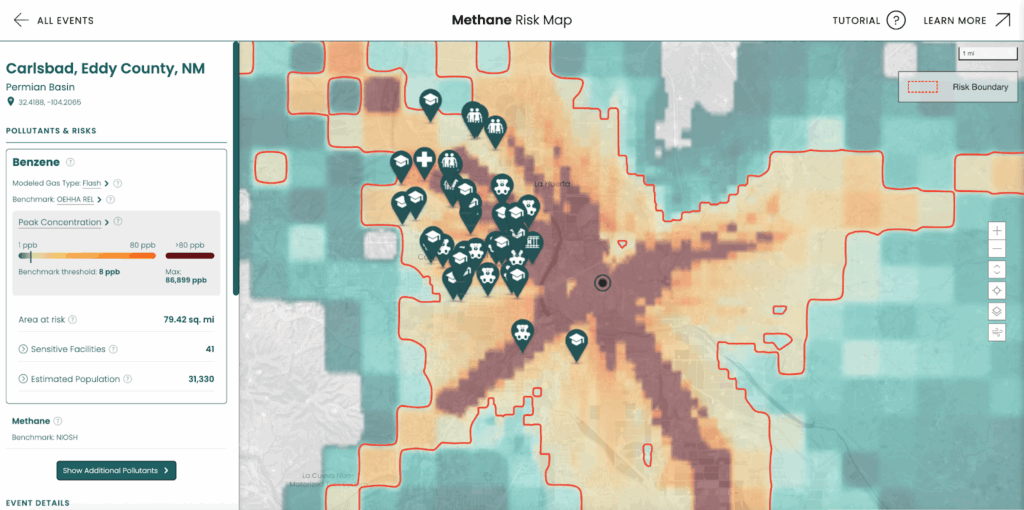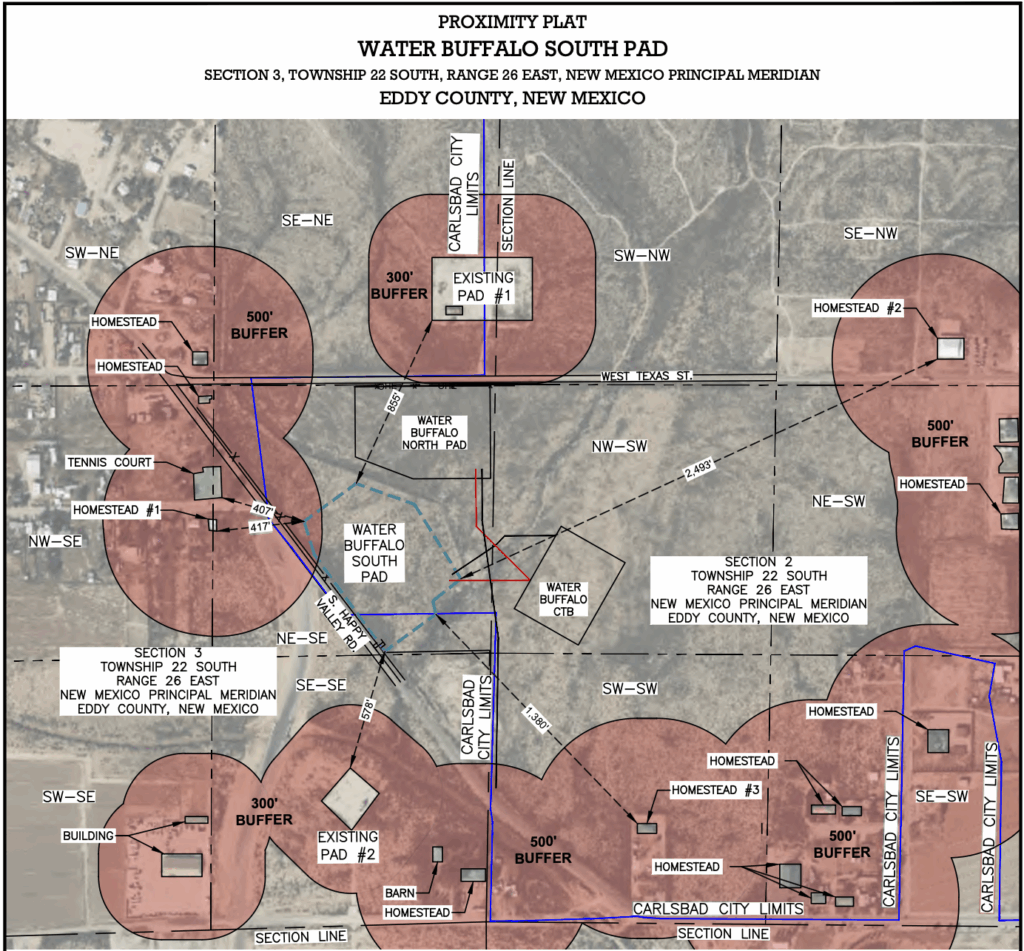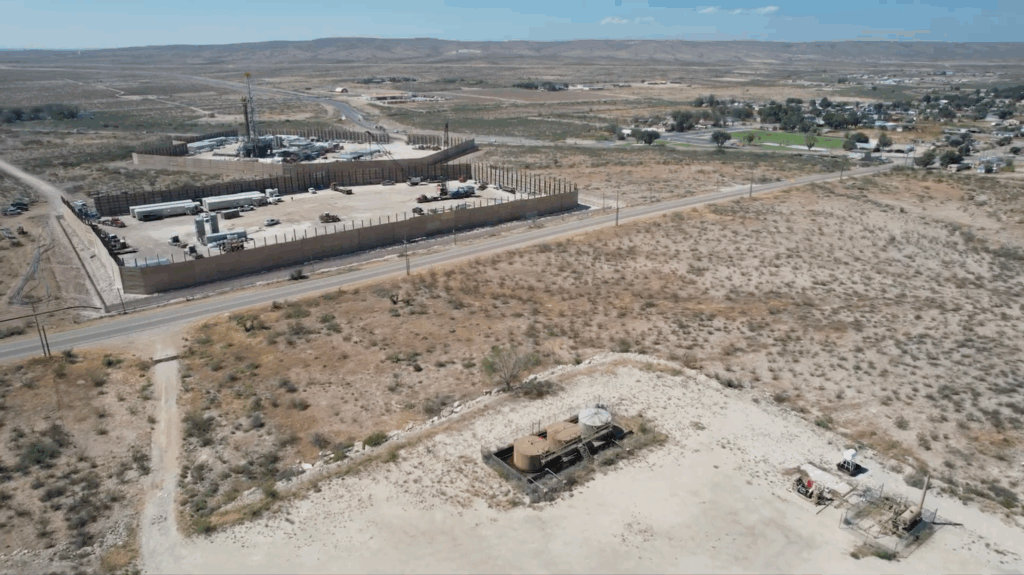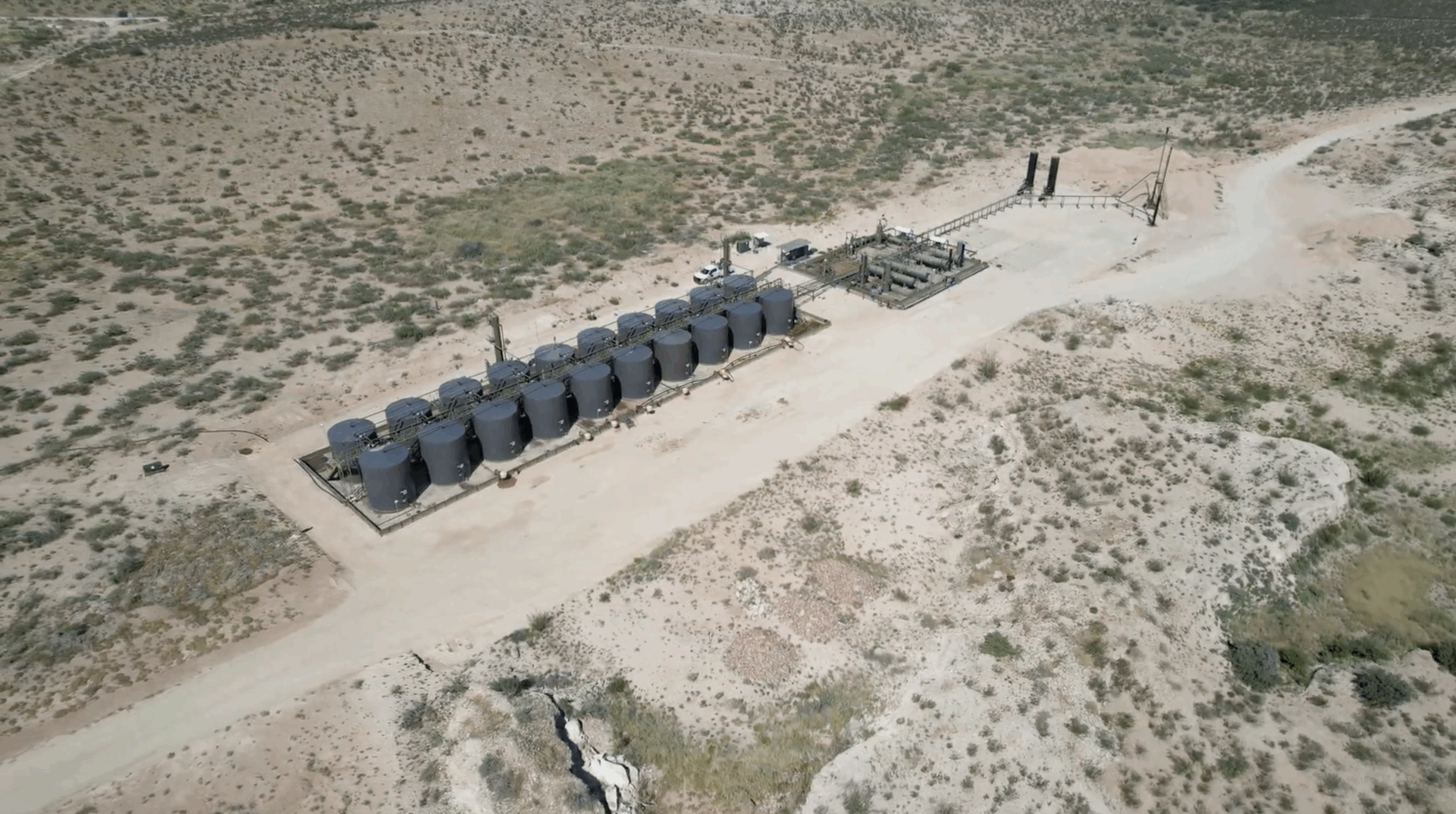Hunterbrook Media’s investment affiliate, Hunterbrook Capital, does not have any positions related to this article at the time of publication. Positions may change at any time. Full disclosures below.
Out in the flatlands near Carlsbad in southeastern New Mexico, a battery of black tanks stores gas from nearby wells. They sit in the Permian Basin, the largest oil-producing basin in the United States and globally. This is where a satellite spectrometer in early February picked up signs of a gaseous discharge: a release of more than 1,400 kilograms of methane per hour, according to nonprofit Carbon Mapper, which specializes in methane and carbon dioxide monitoring. It was not immediately clear from the data when the release began or how long it lasted.
New Mexico’s Energy, Minerals, and Natural Resources Department confirmed to Hunterbrook Media that the tanks are owned by independent oil and gas company Permian Resources ($PR).
Researchers at the independent scientific research institute PSE Health Energy took a closer look at this discharge. They said that based on gas samples in the same county, the release at Permian’s tanks did not just include methane — it was a toxic cocktail consisting of substances like benzene, ethylbenzene, hexane, toluene, and xylenes.
The analysis is part of PSE’s Methane Risk Map, a new environmental tracking tool that visualizes which other hazardous air pollutants are discharged along with methane during releases at oil and gas infrastructure.
Benzene is a carcinogen. Long-term exposure to the chemical can cause leukemia.
According to the PSE researchers’ model, the storage tanks released enough benzene to cause a peak concentration of about 87,000 parts per billion nearby. That’s more than 10,000 times higher than a benchmark set by the California Office of Environmental Health Hazard Assessment (OEHHA).
The PSE team also modeled where the toxic plume moved, based on local weather conditions during the release. The resulting map shows that the contaminant cloud migrated in several directions and covered an area of almost 80 square miles, including large parts of Carlsbad and more than a dozen schools and childcare centers. It exposed more than 30,000 people to benzene, the researchers estimated.

The New Mexico Environment Department confirmed to Hunterbrook that Permian Resources did not report the methane release. It also didn’t report the discharge of hazardous air pollutants like benzene, even though it would apparently be required to do so within 24 hours under state and federal law.
Permian Resources did not respond to multiple requests for comment.
The company, headquartered in Midland, Texas, is “an anomaly” in the oil and gas industry, according to a 2023 profile in Texas Monthly magazine: Its co-CEOs, Will Hickey and James Walter, are both 30-somethings, and its workforce largely consists of millennials and Gen Z — unusually young for a fossil fuel company.
Permian now wants to expand in New Mexico, with its first project within the Carlsbad city limits: 10 new oil wells and a central tank battery, dubbed the “Water Buffalo Unit.”
The company is planning to drill through a groundwater aquifer on the west side of the city, near the unincorporated community of Happy Valley, to access the Wolf Camp and Bonespring formations. The permits were approved by the Carlsbad City Council in June, “on a rare split vote,” according to the Carlsbad Current Argus, despite several residents voicing concerns about oil drilling near their homes.

Carlsbad Mayor Rick Lopez supports the new Permian Resources wells, according to the Carlsbad Current Argus. Kristen Gamboa, executive director of the Carlsbad Department of Development, said at the June city council meeting that the project will bring the city and local mineral rights owners “tens of millions” in oil and gas royalties. Permian Resources also plans to open a field office in Carlsbad with 30 permanent jobs.
Residents, however, are concerned about groundwater pollution and potentially being exposed to air pollutants such as hydrogen sulfide (H2S). Several told Hunterbrook that they generally appreciate the economic benefits of the project, but that they fear the consequences if something goes wrong.
Reagan Washburn is a fourth-generation resident of Happy Valley and described herself as a conservative and “pro oil.” But the proximity of the new oil wells to homes and a park worries her.
“We all have grown up in the oil field in some form of fashion, but I’m not okay with it being in my backyard where it can contaminate our water and possibly cause devastation to thousands of people because of where they’re located,” she told Hunterbrook. “It breaks my heart more than anything that our city council members did not hear our huge outcry or they chose not to.”
Brittany Dye and her family moved to Carlsbad from Orlando about a year ago. She said she sees the economic upside for the city.
“Being involved with the schools and community, I see how much these oil companies give back to our community through donations, sponsorships, and, of course, the job market.” She said it’s not an even trade-off, though, with low-income neighborhoods and schools suffering the most from oil wells being drilled closer to them. “Children are breathing in the emissions at recess when they’re running, playing, and breathing hard.”
Many of the residents Hunterbrook spoke with were unaware of the release at Permian Resources’ tank battery site out east. Methane releases can also occur at oil wells like the ones near Happy Valley — and include the same hazardous pollutants PSE researchers said were contained in the February plume.
Referring to the methane release, Washburn told Hunterbrook, “That’s right where people’s houses are at … it was really hush-hush and there wasn’t a lot of information about it being put out to the public.”
Aaron Ruiz, also a resident of Carlsbad, was shocked to find out about the release. “It seems like stuff like this is easily swept under the rug,” he said.
Government regulators said they were also kept in the dark about the February methane discharge and only learned of it after speaking with Hunterbrook.
According to Michelle Miano, the director of the Environmental Protection Division for the New Mexico Environment Department, and Bruce Baizel, the director of compliance and enforcement, who are tasked with overseeing and regulating air pollution in the state, the release was never reported to them.
“We’re completely under-resourced,” Miano said. Without companies disclosing dangerous gas releases themselves, the department has little ability to track emissions events. “Everybody should be disturbed,” she said.
And even when the Environment Department does bring enforcement actions, Miano said, their approach “has not been enough to make the industry change its behavior.”
When asked about the methane release at Permian’s storage tanks, a spokesperson for New Mexico’s Energy, Minerals, and Natural Resources Department said its staffers managing methane release reports “don’t feel confident providing a response until they can do a field inspection,” because of conflicting information in the department’s database.
A New Mexico Oil Conservation Division (OCD) database shows that Permian reported several emergency gas flares near its tank battery in February, including on February 2 and February 9, but not for February 7, when the methane release was detected by Carbon Mapper.
Mayor Lopez declined to comment on the February methane discharge and its possible implications for the Permian drilling project within city limits.
Hunterbrook drone imagery shows that the construction work at Permian’s new wells is progressing. The project is supposed to be completed by this fall.

Gamboa, the executive director of the Carlsbad Department of Development, was unaware of the methane release at Permian’s tanks east of Carlsbad.
She told Hunterbrook she finds it hard to understand why locals are worried about polluted air and water, given the long history of oil and gas in the region. “It’s nothing new,” she said.
Gamboa acknowledged, however, that she would be similarly worried about the oil wells’ proximity and that there are inherent risks in oil production.
“I mean, no one’s perfect. We’re all humans,” she said. “But I think that everyone’s trying to do their best to the safest degree possible.”
Authors
Till Daldrup joined Hunterbrook from The Wall Street Journal, where he focused on open-source investigations and content verification. In 2023, he was part of a team of reporters who won a Gerald Loeb Award for an investigation that revealed how Russia is stealing grain from occupied parts of Ukraine. He has an M.A. in Journalism from New York University and a B.S. in Social Sciences from University of Cologne. He’s also an alum of the Cologne School of Journalism (Kölner Journalistenschule). Till is based in New York.
Michelle Cera trained as a sociologist specializing in digital ethnography and pedagogy. She completed her PhD in Sociology at New York University, building on her Bachelor of Arts degree with Highest Honors from the University of California, Berkeley. She has also served as a Workshop Coordinator at NYU’s Anthropology and Sociology Departments, fostering interdisciplinary collaboration and innovative research methodologies.
Editor
Sam Koppelman is a New York Times best-selling author who has written books with former United States Attorney General Eric Holder and former United States Acting Solicitor General Neal Katyal. Sam has published in the New York Times, Washington Post, Boston Globe, Time Magazine, and other outlets — and occasionally volunteers on a fire speech for a good cause. He has a BA in Government from Harvard, where he was named a John Harvard Scholar and wrote op-eds like “Shut Down Harvard Football,” which he tells us were great for his social life. Sam is based in New York.
Hunterbrook Media publishes investigative and global reporting — with no ads or paywalls. When articles do not include Material Non-Public Information (MNPI), or “insider info,” they may be provided to our affiliate Hunterbrook Capital, an investment firm which may take financial positions based on our reporting. Subscribe here. Learn more here.
Please email ideas@hntrbrk.com to share ideas, talent@hntrbrk.com for work, or press@hntrbrk.com for media inquiries.
LEGAL DISCLAIMER
© 2025 by Hunterbrook Media LLC. When using this website, you acknowledge and accept that such usage is solely at your own discretion and risk. Hunterbrook Media LLC, along with any associated entities, shall not be held responsible for any direct or indirect damages resulting from the use of information provided in any Hunterbrook publications. It is crucial for you to conduct your own research and seek advice from qualified financial, legal, and tax professionals before making any investment decisions based on information obtained from Hunterbrook Media LLC. The content provided by Hunterbrook Media LLC does not constitute an offer to sell, nor a solicitation of an offer to purchase any securities. Furthermore, no securities shall be offered or sold in any jurisdiction where such activities would be contrary to the local securities laws.
Hunterbrook Media LLC is not a registered investment advisor in the United States or any other jurisdiction. We strive to ensure the accuracy and reliability of the information provided, drawing on sources believed to be trustworthy. Nevertheless, this information is provided "as is" without any guarantee of accuracy, timeliness, completeness, or usefulness for any particular purpose. Hunterbrook Media LLC does not guarantee the results obtained from the use of this information. All information presented are opinions based on our analyses and are subject to change without notice, and there is no commitment from Hunterbrook Media LLC to revise or update any information or opinions contained in any report or publication contained on this website. The above content, including all information and opinions presented, is intended solely for educational and information purposes only. Hunterbrook Media LLC authorizes the redistribution of these materials, in whole or in part, provided that such redistribution is for non-commercial, informational purposes only. Redistribution must include this notice and must not alter the materials. Any commercial use, alteration, or other forms of misuse of these materials are strictly prohibited without the express written approval of Hunterbrook Media LLC. Unauthorized use, alteration, or misuse of these materials may result in legal action to enforce our rights, including but not limited to seeking injunctive relief, damages, and any other remedies available under the law.
